Tyler Irving
February 11, 2016
This story originally appeared on U of T Engineering News.
On the first International Day of Women and Girls in Science, we’re excited to highlight eight U of T Engineering professors — all appointed in recent years — that are creating innovative solutions in bioengineering, sustainability, communications and enabling technologies. This article originally appeared in the 2015 issue of Skulematters.
Gisele Azimi
Making the most of rare earths
 Rare earth elements (REEs) — neodymium, cerium, samarium and 14 others — are found in an increasing number of technologically advanced products. Their unique magnetic properties are critical for making everything from smartphones and earbud headphones to wind turbines and electric cars. Their ability to speed up chemical reactions makes them useful in manufacturing as well as in automotive catalytic converters. Because of their importance to the economy, developed countries including Canada have accelerated efforts to satisfy demand of rare earth elements.
Rare earth elements (REEs) — neodymium, cerium, samarium and 14 others — are found in an increasing number of technologically advanced products. Their unique magnetic properties are critical for making everything from smartphones and earbud headphones to wind turbines and electric cars. Their ability to speed up chemical reactions makes them useful in manufacturing as well as in automotive catalytic converters. Because of their importance to the economy, developed countries including Canada have accelerated efforts to satisfy demand of rare earth elements.
Gisele Azimi (ChemE, MSE) is using her unique knowledge of materials science and chemical engineering to change the way we extract, utilize and recycle these elements. She is developing chemical processing techniques that can extract REEs not only from natural resources, but also from materials that would otherwise be discarded as waste. For example, Azimi and her team are creating processes that can be used on old automobile catalytic converters to recover not only REEs, but also precious metals such as platinum.
During her post-doctoral studies at MIT, Azimi discovered a new property of REEs: when made into ceramics, they have a powerful ability to repel water. These ceramics can be applied to airplane wings or wind turbine blades to prevent ice buildup, making these technologies safer. They can also be applied to steam turbine blades or condensers — key pieces of industrial process equipment — to increase efficiency and reduce energy use.
On the extraction side, Azimi and her team are currently optimizing a technique for recovering REEs from phosphogypsum, a byproduct of the fertilizer industry, as well as automotive catalytic converters. They also partnered with researchers at the U of T Engineering’s Centre for Advanced Coating Technologies to develop the spray-coating techniques needed to commercially apply their new water-repelling ceramics.
“Rare earth elements can address a wide range of sustainability issues, from better electric cars and wind turbines to more energy-efficient processes. I believe researching extraction and utilization of these elements paves the way to take on the big challenges in energy and the environment.”
Amy Bilton
Water and energy technologies for remote communities
 Modern plants for water treatment or energy generation are typically designed to feed into existing infrastructure, such as city-wide plumbing or electrical grids. But people in remote communities — especially in the developing world — often lack this infrastructure. When areas with small or widely dispersed populations can’t afford the latest and greatest, they have to make do with older, less effective technologies, or simply go without.
Modern plants for water treatment or energy generation are typically designed to feed into existing infrastructure, such as city-wide plumbing or electrical grids. But people in remote communities — especially in the developing world — often lack this infrastructure. When areas with small or widely dispersed populations can’t afford the latest and greatest, they have to make do with older, less effective technologies, or simply go without.
Amy Bilton (MIE) and her team specialize in the creation of small, low-cost water and energy systems for remote communities in the developing and developed world. They use custom computer tools to optimize the design of technologies for local conditions, taking into account cost, availability of local materials and expertise required for maintenance. Where practical, they take advantage of renewable energy resources, such as wind and solar power.
 One of Bilton’s projects involves working with communities in Mexico’s Yucatan Peninsula and development organizations such as Fondo para La Paz to design small-scale desalination plants. These plants, which are powered by solar energy, take brackish groundwater and make it drinkable. Another project, still in the development stages, involves using renewable energy to improve oxygen exchange in fish farms in Vietnam. This will improve yields of fish, which are an important source of protein in the developing world.
One of Bilton’s projects involves working with communities in Mexico’s Yucatan Peninsula and development organizations such as Fondo para La Paz to design small-scale desalination plants. These plants, which are powered by solar energy, take brackish groundwater and make it drinkable. Another project, still in the development stages, involves using renewable energy to improve oxygen exchange in fish farms in Vietnam. This will improve yields of fish, which are an important source of protein in the developing world.
This year, Bilton was approached by a team from Winds of Change, an organization doing development work in Pedro Arauz, Nicaragua. It was looking for help to design a windmill that could automate the pumping of groundwater to help farmers survive the long, dry season in that part of the world. Bilton assembled a multidisciplinary team of undergraduate students that flew to Nicaragua to consult with local farmers and gather data on weather patterns. The resulting windmill is due to be constructed this fall.
“Sometimes it’s the simple technologies that can make some of the biggest improvements in quality of life for people. I love working in an area where I can make a connection with a community and see the direct impact of my work.”
Hai-Ling Margaret Cheng
Visualizing the human body
 Magnetic resonance imaging (MRI) is one of the more powerful, non-invasive techniques we have for looking inside the body. Though it’s not as sharp as an x-ray, it avoids the health risks associated with x-ray radiation. MRI is commonly used to diagnose cancer and brain disease. However, Hai-Ling Margaret Cheng (IBBME, ECE) believes it can do much more.
Magnetic resonance imaging (MRI) is one of the more powerful, non-invasive techniques we have for looking inside the body. Though it’s not as sharp as an x-ray, it avoids the health risks associated with x-ray radiation. MRI is commonly used to diagnose cancer and brain disease. However, Hai-Ling Margaret Cheng (IBBME, ECE) believes it can do much more.
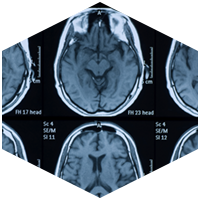 MRI works by using a magnetic field to excite the hydrogen atoms in a particular part of the body. These atoms then give off radio-frequency signals that can be detected. Cheng and her team are devising ways to generate new signal contrast from tissues and new approaches to analyzing the imaging data. Though the techniques are new, they are designed for use on existing MRI scanners, allowing them to be widely applied. The goal is to extract more quantitative information from the scans and probe beyond anatomy into the physiological, cellular and molecular level.
MRI works by using a magnetic field to excite the hydrogen atoms in a particular part of the body. These atoms then give off radio-frequency signals that can be detected. Cheng and her team are devising ways to generate new signal contrast from tissues and new approaches to analyzing the imaging data. Though the techniques are new, they are designed for use on existing MRI scanners, allowing them to be widely applied. The goal is to extract more quantitative information from the scans and probe beyond anatomy into the physiological, cellular and molecular level.
If MRI can be made to look beyond anatomy, we may be able to detect many diseases much sooner. For example, if we can detect the changed cellular activity of cancer cells, we will be able to detect smaller tumours and catch cancer earlier on in the process, when chances of survival are greatest. But Cheng has even bigger ambitions. She aims to use MRI on tissue grafts or other implants, creating a non-invasive way to see how well they are integrating into the body. Such an approach could also guide the development of new and emerging stem cell-based therapies.
Cheng and her team are collaborating with U of T chemists to develop new contrast agents — compounds that can be injected into the body to light up even smaller features in MRI scans. These agents, combined with tweaks to how the machine works, will enable MRI to better diagnose disease and actively track how well treatments are working. A better picture of what is going on in the body will help scientists repair damage and treat major diseases, including cancer and cardiovascular conditions.
“I chose MRI because I wanted to do something to help people and contribute to society. I previously worked in aerospace, and I knew a lot about how signals are processed from radar, for example. MRI signals are processed in a somewhat similar way, so the marriage of biomedical research and electrical engineering was a perfect fit.”
Natalie Enright Jerger
Designing faster computers
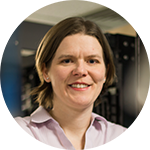 Every few years, advances in manufacturing technology dramatically increase the number of components that can be etched onto a computer chip. Yet designing a faster computer isn’t simply a matter of fitting more circuits into less space. The arrangement of components into an integrated processor must be carefully designed, a process known as computer architecture.
Every few years, advances in manufacturing technology dramatically increase the number of components that can be etched onto a computer chip. Yet designing a faster computer isn’t simply a matter of fitting more circuits into less space. The arrangement of components into an integrated processor must be carefully designed, a process known as computer architecture.
 Natalie Enright Jerger (ECE) is a leading computer architect. In her lab, she develops computer programs that can simulate various arrangements of processor components. The simulations allow the team to test out many different designs and optimize them for computing speed, power usage, cost, size and a host of other parameters. Chip manufacturers such as Intel, AMD and Qualcomm collaborate with Enright Jerger to turn these new ideas into reality.
Natalie Enright Jerger (ECE) is a leading computer architect. In her lab, she develops computer programs that can simulate various arrangements of processor components. The simulations allow the team to test out many different designs and optimize them for computing speed, power usage, cost, size and a host of other parameters. Chip manufacturers such as Intel, AMD and Qualcomm collaborate with Enright Jerger to turn these new ideas into reality.
One recent project in the lab revolved around a technique called approximate computing. The method takes advantage of the fact that for some applications, the odd processing error is acceptable. For example, in a streaming video, a few incorrect pixels per frame would go unnoticed by most viewers. A low, controlled error rate can allow for faster processing without the need for more power and increasing battery life for portable devices.
The team is also working on a project that aims to overcome the limitations of larger computer chips. As chips increase in size, the chances of one component failing and rendering the whole chip defective are increased. In the lab, Enright Jerger and her students are developing ways of making large chips by networking many smaller chips together. This helps reduce the material and manufacturing costs of superior computing power low.
“Computers touch every aspect of people’s lives. Being able to provide easy access to tremendous amounts of information is a really exciting capability. I also enjoy the intellectual challenge of trying to solve this really cool engineering puzzle.”
Penney Gilbert
Engineering muscle
 Our muscles constantly repair and remodel themselves in response to the stresses they experience. However, as we age, this ability wanes and we become more prone to falls. Injuries from falls cost Canada’s health-care system close to $2 billion each year. On top of that, muscle wasting is a common feature of many genetic and neuromuscular disorders.
Our muscles constantly repair and remodel themselves in response to the stresses they experience. However, as we age, this ability wanes and we become more prone to falls. Injuries from falls cost Canada’s health-care system close to $2 billion each year. On top of that, muscle wasting is a common feature of many genetic and neuromuscular disorders.
Penney Gilbert (IBBME) uses human stem cells to grow tiny facsimiles of human muscle in the lab. Her creations are more than simply masses of cells; they organize themselves into long muscle fibres and even incorporate nerve cells that tell the muscle when to twitch in response to a stimulus. Growing these tiny model muscles outside the body has taught Gilbert and her team a lot about how stem cells transform into the tissues they will become.
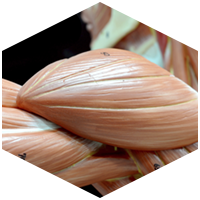 By understanding how stem cells become muscle, Gilbert and her team are developing strategies to help repair muscle in the elderly or anyone else experiencing muscle wasting. For example, they are working to discover drugs that could stimulate the body’s own stem cells to regenerate muscle tissue. Further in the future, if lab-grown muscles can be made large enough, they could even implant new muscles grown from the patient’s own cells.
By understanding how stem cells become muscle, Gilbert and her team are developing strategies to help repair muscle in the elderly or anyone else experiencing muscle wasting. For example, they are working to discover drugs that could stimulate the body’s own stem cells to regenerate muscle tissue. Further in the future, if lab-grown muscles can be made large enough, they could even implant new muscles grown from the patient’s own cells.
Gilbert and her team have made many copies of their tiny muscle facsimiles, which can be used to screen libraries of known chemical compounds for their ability to stimulate muscle repair. Because these samples can be grown from a patient’s own cells, the screens can tell which drugs are most likely to be effective in that particular patient, a significant step toward personalized medicine.
“Engineers think about science in a really different way. They create tools that allow us to ask biological questions that we couldn’t otherwise ask. I love thinking about biology with engineering principles in mind.”
Keryn Lian
Powering the Future
 With billions of electronic devices already on the market and a growing worldwide interest in electric vehicles, providing portable power is a key engineering challenge for the future. Next-generation power sources will have to be smaller, lighter and less expensive than existing options. Moreover, if they can be made flexible enough, they could make a game-changing difference in the burgeoning market for wearable devices, from smart watches to temperature-responsive clothing.
With billions of electronic devices already on the market and a growing worldwide interest in electric vehicles, providing portable power is a key engineering challenge for the future. Next-generation power sources will have to be smaller, lighter and less expensive than existing options. Moreover, if they can be made flexible enough, they could make a game-changing difference in the burgeoning market for wearable devices, from smart watches to temperature-responsive clothing.
 Keryn Lian (MSE) and her team build electrochemical capacitors. Electrochemical capacitors store charge via ion adsorption and/or changing chemical reactions into electricity and vice versa, such as rechargeable batteries. However, the power and the rate at which they discharge are much higher than traditional batteries. This makes them ideal for providing a boost of power when needed, such as when an electric vehicle is driving up a hill or when a power-hungry app is activated. Though some electrochemical capacitors are commercially available, Lian and her team are experimenting with new materials that could reduce costs while maintaining or improving performance.
Keryn Lian (MSE) and her team build electrochemical capacitors. Electrochemical capacitors store charge via ion adsorption and/or changing chemical reactions into electricity and vice versa, such as rechargeable batteries. However, the power and the rate at which they discharge are much higher than traditional batteries. This makes them ideal for providing a boost of power when needed, such as when an electric vehicle is driving up a hill or when a power-hungry app is activated. Though some electrochemical capacitors are commercially available, Lian and her team are experimenting with new materials that could reduce costs while maintaining or improving performance.
The devices Lian and her team are building are based on membranes made of ionically conductive polymers, a kind of plastic. Because they contain no liquid, they can’t leak like batteries. They are also smaller, lighter and can be made flexible enough to fit into almost any space, whether it’s the body of a vehicle, the casing of a mobile phone or the underside of a solar panel. Inexpensive electrochemical capacitors could dramatically increase the performance of any of these products.
One of Lian’s students recently created a flexible polymer electrolyte membrane that conducts charge faster than any other, even beating some liquid electrolytes used in today’s batteries. Other projects involve making electrodes out of agricultural waste — corncobs, for example — to reduce material and manufacturing costs. Lian collaborates with industrial partners to bring these new technologies to market.
“People are using more and more energy, but they don’t want to have to carry additional weight. The market for flexible electronics is getting bigger and bigger. Anything we can do to make people’s lives easier will be the right way to go.”
Elodie Passeport
Green Infrastructures to Remove Environmental Contaminants
 Each year, humans use thousands of tonnes of organic chemical compounds, such as pharmaceuticals, antibiotics, pesticides and more. These substances eventually make their way into streams, lakes and oceans. Many of these compounds are known or suspected to have potentially toxic effects on these aquatic ecosystems and need to be removed. Yet, surprisingly little is known about how they move through the environment, or their final fate.
Each year, humans use thousands of tonnes of organic chemical compounds, such as pharmaceuticals, antibiotics, pesticides and more. These substances eventually make their way into streams, lakes and oceans. Many of these compounds are known or suspected to have potentially toxic effects on these aquatic ecosystems and need to be removed. Yet, surprisingly little is known about how they move through the environment, or their final fate.
Elodie Passeport (CivE, ChemE) is dealing with this problem through two complementary strategies. Using isotope ratio mass spectrometry — a chemical analysis technique — Passeport and her team can trace the fate of the chemical contaminants in samples collected from industrial, agricultural and urban areas. For example, they can determine whether the chemicals are being broken down by bacteria or sunlight, or merely sticking to soil or clay. In the lab, Passeport and her team validate this work by building working models of wetlands or other natural and engineered ecosystems.
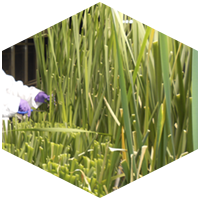 Passeport aims to usher in a new era of “green infrastructures” by redesigning wastewater treatment systems to take advantage of natural processes, including bacterial action, that break down or filter out harmful compounds. Her work will also influence government policy by helping to identify where compounds end up and which ones need to be regulated most urgently.
Passeport aims to usher in a new era of “green infrastructures” by redesigning wastewater treatment systems to take advantage of natural processes, including bacterial action, that break down or filter out harmful compounds. Her work will also influence government policy by helping to identify where compounds end up and which ones need to be regulated most urgently.
Passeport is collaborating with Ontario companies that design bioretention cells, a water treatment system that leverages natural processes to remove organic chemical contaminants from stormwater runoff. Her work will determine the roles played by each element of the system, including soil composition, water levels and vegetation, and help optimize overall function.
“My goal is to see better, more integrated management of environmental problems. This means small treatment systems in homes combined with efficient, large-scale processes that mimic nature. I want to put all my efforts into preserving our environment.”
Angela Schoellig
Scanning from the sky
 Canada is full of sparsely populated landscapes: think of an expanse of prairie, or a northern forest dotted with small lakes. Keeping track of environmental conditions in these vast areas is a labour-intensive process. But the rise of unmanned aerial vehicles (UAVs), also called drones, could be a game-changer.
Canada is full of sparsely populated landscapes: think of an expanse of prairie, or a northern forest dotted with small lakes. Keeping track of environmental conditions in these vast areas is a labour-intensive process. But the rise of unmanned aerial vehicles (UAVs), also called drones, could be a game-changer.
Angela Schoellig (UTIAS) helps drones learn to fly themselves more accurately and safely. Schoellig and her team develop algorithms that allow UAVs to take information from sensors such as onboard cameras and analyze it to figure out where they are. She’s also working to enable drones to sense when conditions are too rainy or windy to fly and park themselves until conditions improve.
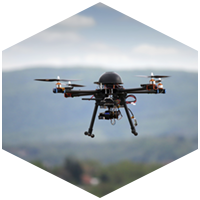 Some UAVs are currently used for environmental monitoring, such as scanning farmers’ fields for pest infestations. However, these devices depend to a large degree on radio control from ground stations or from GPS signals; if these are unavailable, the drone becomes lost, and can’t always find a safe place to land. They also have trouble coping with unforeseen conditions, from wind gusts to full-blown storms. If Schoellig and her team can enable drones to learn from their surroundings, it would allow them to range well beyond their current reach and stay in the field for longer periods of time. Teams of drones could cover large areas more efficiently than any currently available technology.
Some UAVs are currently used for environmental monitoring, such as scanning farmers’ fields for pest infestations. However, these devices depend to a large degree on radio control from ground stations or from GPS signals; if these are unavailable, the drone becomes lost, and can’t always find a safe place to land. They also have trouble coping with unforeseen conditions, from wind gusts to full-blown storms. If Schoellig and her team can enable drones to learn from their surroundings, it would allow them to range well beyond their current reach and stay in the field for longer periods of time. Teams of drones could cover large areas more efficiently than any currently available technology.
Schoellig recently embarked on a project aimed at using drones to monitor toxic algae blooms in freshwater lakes. The UAVs use floats to land on the surface of the lake and dip a small sensor into the water, scanning with a laser to measure algae concentration. The technology would allow researchers to take more samples from many locations within a lake or many lakes in a geographic area, and sample much more frequently than is currently possible. If the warning signs of a toxic bloom are detected early enough, humans could intervene, releasing chemical or biological agents to stop the bloom before it starts.
“I did a lot of theoretical research into automation but I really wanted to see the math in action. For decades, robots have been working in industrial settings where the environment is very predictable. I was excited by the challenge of taking robots into the real world.”
More information:
Leanne Moss
Communications Assistant
The Edward S. Rogers Sr. Department of Electrical & Computer Engineering
416-978-1999; leanne.moss@utoronto.ca